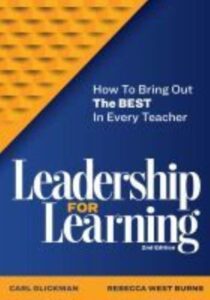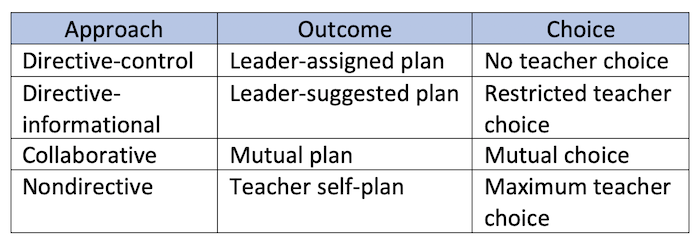[ad_1]
Leadership for Learning: How to Bring Out the Best in Every Teacher, 2nd Edition
By Carl Glickman and Rebecca West Burns
(ASCD, 2022 – Learn more)
Reviewed by Cathy Gassenheimer

This is a tough time for educators. The pandemic still lingers; addressing the requisite learning loss caused by Covid is a hard reality; high stakes testing still looms.
Schools are also facing an influx of new teachers, many of whom are working on their professional certification as they teach and need extra on-the-job training and support to succeed in the classroom.
Add to all this the many unfair criticisms aimed at schools, and it’s no surprise many teachers and school leaders are questioning whether they want to continue to work in such stressful times in education.
 Fortunately, a new edition of a popular leadership book provides research-based strategies to help administrators support teachers and other educators in their building or district.
Fortunately, a new edition of a popular leadership book provides research-based strategies to help administrators support teachers and other educators in their building or district.
The book, Leadership for Learning: How to Bring Out the Best in Every Teacher (ASCD, 2022), is written by a pair of seasoned and skillful educators, Carl Glickman and Rebecca West Burns.
Glickman is a professor emeritus of education at the University of Georgia. In the mid-1980s Glickman formed the Georgia League of Professional Schools, designed to enable teachers and administrators to become more knowledgeable, thoughtful, and purposeful about planning, implementing, and researching their own work.
This network of schools served as an inspiration to progressive education leaders and advocates in several other Southeastern states, including Alabama, where I worked for more than 20 years to help develop the Alabama Best Practices Center, a nonprofit supporting networks of teachers and administrators to develop “the competence, confidence, and courage to do whatever it takes to improve student learning.”
Co-author Rebecca West Burns is an associate professor at the University of South Florida’s College of Education who works closely with educators across Florida and elsewhere. She was recently awarded the Shirley S. Schwartz Urban Education Impact Award from the Council of the Great City Schools.
As you can surmise, both Glickman and Burns are hands-on experts who work directly with districts and schools. No ivory-tower thinking here.
If I had the resources, I’d put a copy of this book in the hands of every leader across the country – a notion shared by one of the endorsers of this book, Michael Consenza, who serves as the president of the National Association for Professional Development Schools.
Why? It provides practical, just-in-time ideas to support and develop every educator in a leader’s school or district.
Identification of a leader’s role
in the book the authors suggest the role of a leader should be to “achieve results while preserving their moral responsibility to their students and staff (Glickman, 1987, Sergiovanni & Starratt, 2007); evaluate the consequences of their decisions, and advocate for policy and practices that are aligned with research, and recognize, respond to, and redress inequities in education to ensure all students and all teachers can learn and grow (Gorski, 2013)” p. 3.
Perhaps you felt a bit startled when you read that all-encompassing charge. And wondered how in the world any leader could meet such a challenge.
Answering that question is the purpose of the book: Glickman and Burns provide detailed and specific research, protocols, and ideas to get you started or to advance the good work you are already doing.
Some key ideas from the book
Glickman and Burns advocate for:
● The imperative to “deprivatize” teaching practice by nurturing collaboration and building collective teacher efficacy in every school.
● Ongoing and differentiated professional learning to meet the needs of every teacher.
● Peer coaching: Creating formal and informal leadership roles for highly successful teachers.
● The leader as coach: Strategies to help develop teachers through observations to “foster risk-taking and growth” (p. 36).
● Carefully differentiating observations to foster growth and formal visitations for teacher evaluation so that teachers know your specific role when you work with them.
● Vital communication skills that all leaders need to build trust and help grow and nurture teachers successfully.
● The six dimensions of adult and teacher development, including (1) cognitive development, (2) conceptual development, (3) levels of consciousness, (4) moral development, (5) ego development, and (6) stages of concern (p. 87).
● Differentiating one’s approach to working with teachers based on their current status, style, and beliefs.
● Making the most of teachable moments, and
● Being mindful and addressing the social and emotional needs of your colleagues.
Connecting to other education thought leaders
As I read the book, I saw so many connections to the thinking of Robert Garmston and Arthur Costa, the creators of Cognitive Coaching; to Michael Fullan, who reminds us of the moral imperative of teaching and leading, and to Jim Knight and his instructional coaching and partnership principles.
As an example, Glickman and Burns describe four approaches to working with teachers:
Obviously, the directive-control approach should only be used when the leader sees a critical issue requiring immediate action in the classroom. As the authors note, directive control “should be used only in an emergency situation in which a teacher is overwhelmed, paralyzed, totally inexperienced, or incompetent in the current classroom situation” (p 82).
The other three choices operate on a continuum as the leader strives to differentiate support based on the needs of each individual teacher.
For example, the directive-informational approach provides a teacher with what Knight calls “freedom within form.” The leader suggests several alternative actions from which a teacher might choose.
The final two approaches align nicely with Knight’s suggested strategies in his bestselling book The Impact Cycle, although with the use of different terms. Knight’s Dialogical aligns with Glickman and Burns’s collaborative approach, and his Facilitative approach aligns with Glickman and Burns’ Nondirective approach. Knight, The Impact Cycle, p. 10
Knight, The Impact Cycle, p. 10
Full of actionable suggestions
Leadership for Learning is full of ideas, suggestions, and research-based strategies that a leader can immediately put into action. One of the most useful parts of the book provides case studies of teachers at different levels of development and how a leader can pursue the four approaches described above to meet specific needs.
It’s a desktop book
If I were a school leader, this book would be on my desk or easily accessible. It’s almost as good as having Glickman or Burns by your side, coaching and counseling you. The book can be a guide to addressing the countless challenges you face. Using it will provide an abundant return on your investment of the purchase price and will help ensure that teaching and leading in your school or district steadily improves.
Cathy Gassenheimer is a professional learning consultant specializing in collaborative adult learning and collective efficacy. For 22 years she was Executive Vice President of the Alabama Best Practices Center, a program of Alabama’s statewide business/community nonprofit A+ Education Partnership, and led the work of three statewide educator networks focused on teaching, leadership, and instructional coaching. Connect with her via LinkedIn and on Twitter @cathygassenheim.
[ad_2]
Source link
Related posts
Today's pick
Recent Posts
- The Road Less Paved: An Introduction to Gravel Biking – Steven Rindner
- DIY Moving vs. Professional Movers: Navigating the Best Path for Your Relocation – Safe Ship Moving Services
- The Debt Ceiling and Technological Innovation: Navigating Future Frontiers – Kavan Choksi
- The Federal Reserve: Navigating Business Impacts – Kavan Choksi
- Embracing Community: The Ascendance of Multifamily Living – Kanat Sultanbekov
Archives
Categories
| M | T | W | T | F | S | S |
|---|---|---|---|---|---|---|
| 1 | 2 | 3 | 4 | 5 | 6 | 7 |
| 8 | 9 | 10 | 11 | 12 | 13 | 14 |
| 15 | 16 | 17 | 18 | 19 | 20 | 21 |
| 22 | 23 | 24 | 25 | 26 | 27 | 28 |
| 29 | 30 | |||||
